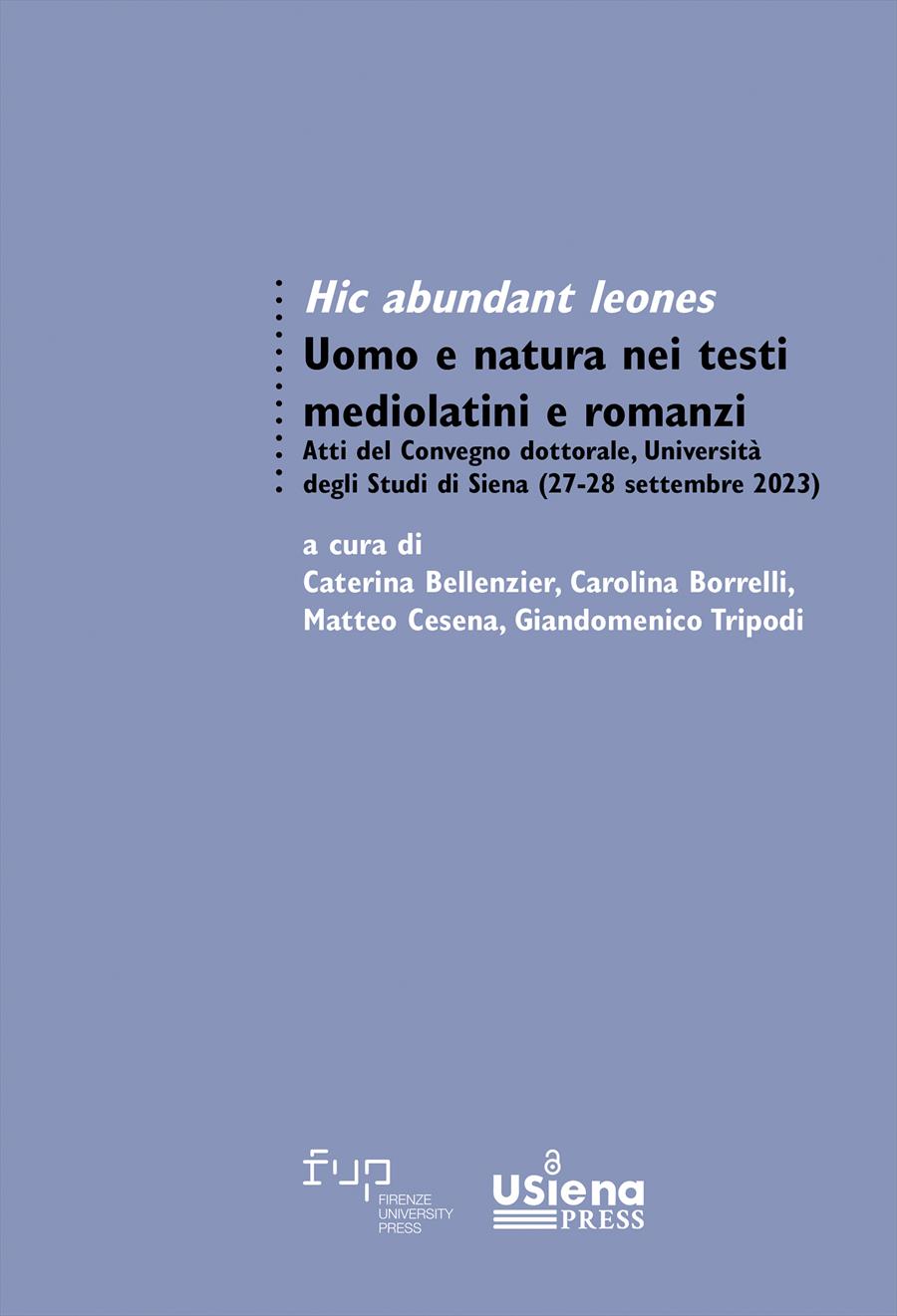- Hic abundant leones. Uomo e natura nei testi mediolatini e romanzi
- Edited by Caterina Bellenzier, Carolina Borrelli, Matteo Cesena, Giandomenico Tripodi
«Roma, quondam orbis caput, nunc nudum nomen et fabula»: rovine materiali e morali nel De situ urbis veteris et inclyte urbis Rome di Pier Paolo Vergerio
- Martina Piccolo
- © 2024 Author(s) |
- CC BY-SA 4.0
- DOI: 10.36253/979-12-215-0602-0.24
The present contribution aims to investigate the sources used by Vergerio in De situ veteris et inclyte urbis Rome, an unfinished treatise of a topographical and archaeological-antiquarian nature. In the wake of Petrarch - the true proponent of the topos of the ‘memory of Rome’ - Vergerio offers the reader a far from sweetened representation of the Urbe. Of particular interest is the relationship with sources, especially the Mirabilia urbis Romae, from which the descriptions of the city gates are taken, for example. De situ is also based on Vergerio’s reading of other authors such as Paolo Diacono, Martino Polono and Petrarch, whom he approaches through an original yet critical approach, with the aim of refuting some medieval beliefs about the main sights of the city of Rome.
- Keywords:
- Pier Paolo Vergerio,
- Humanism,
- Ancient Rome,
- Ruins,
International Society for the Study of Medieval Latin Culture - SISMEL, Italy - ORCID: 0000-0001-5151-7753
- Bonanno, Daniela, e Corinne Bonnet. 2018. “Uomo e ambiente nel mondo greco: premesse, risultati e piste di ricerca.” ὅρμος. Ricerche di storia antica 3: 89-99. DOI: 10.7430/HORMOS1005
- De Caprio, Vincenzo. 1987. “«Sub tanta diruta mole»: il fascino delle rovine di Roma nel Quattro e Cinquecento.” In Poesie e poetica delle rovine di Roma. Momenti e problemi, a cura di Vicenzo De Caprio, 23-52. Roma: Istituto Nazionale di Studi Romani.
- Diacono, Paolo. 2013. Storia dei Longobardi. a cura Lidia Capo. Milano: Fondazione Lorenzo Valla-A. Mondadori.
- Guido da Pisa. 2013. Expositiones et glose declaratio super ‘Comediam’ Dantis, a cura di Michele Rinaldi, appendice a cura di Paola Locatin. Roma: Edizione Nazionale dei Commenti danteschi, Salerno editrice.
- Lupi, Francesco. 2014. “«Habent et urbes suum terminum». Rovina e decadenza in alcuni luoghi dell’Umanesimo italiano.” Studi di italianistica nell’Africa australe 27: 1-26.
- Malatesta, Sigismondo. 1886. Statuti delle gabelle di Roma. Roma: Tipografia della pace di Filippo Cuggiani.
- MGH (Monumenta Germaniae Historica), SS, XXII. 1872. Martini Oppiavensis Chronicon pontificum et imperatorum, ed. Ludwig Weiland. Hannoverae: 377-482.
- Morawski, Joseph. (1925) 2007. Proverbes français antérieurs au XV siècle. Paris: Champion.
- Parthey, Gustav. edidit. 1869. Mirabilia Romae. E codicibus vaticanis emendata. Berolini: In aedibus Friderici Nicolai.
- Petrarca, Francesco 2005. Contra eum qui maledixit Italiae. a cura di Monica Berté. Firenze: Le Lettere.
- Piacentini, Angelo. 2015. “La città di Roma nell’Itinerarium di Bartolomeo Bayguera.” In Miscellanea greco latina III, a cura di Stefano Costa e Federico Gallo, 321-73. Roma-Milano: Bulzoni-Biblioteca Ambrosiana.
- Piaia, Gregorio. 1983. “La fondazione filosofica della teoria conciliare di Francesco Zabarella.” In Scienza e filosofia all’Università di Padova nel Quattrocento, a cura di Antonio Poppi, 432-61. Trieste: Lint.
- Revest, Clémence. 2020. “La rhétorique académique de Francesco Zabarella, entre scolastique et humanisme.” In Diritto, chiesa e cultura nell’opera di Francesco Zabarella, 1460-1417, a cura di Chiara Maria Valsecchi e Francesco Piovan, 223-38. Milano: Angeli. DOI: 10.17396/100966
- Steiner, Arpad. 1944. “The Vernacular Proverb in Mediaeval Latin Prose.” The American Journal of Philology 1: 37-68.
- Valsecchi, Chiara Maria. 2020. “Zabarella Francesco.” Dizionario Biografico degli Italiani 100, 277-82. Roma: Istituto della Enciclopedia Italiana. DOI: 10.7393/DBIOL-179
- Venier, Matteo. 2020a. “Vergerio, Pier Paolo, il Vecchio.” Dizionario Biografico degli Italiani 98, 754-57. Roma: Istituto dell’Enciclopedia Italiana.
- Venier, Matteo. 2020b. “Vergerio e Zabarella: fra autentici e presunti autografi.” In Diritto, chiesa e cultura nell’opera di Francesco Zabarella, 1460-1417, a cura di Chiara Maria Valsecchi e Francesco Piovan, 336-49. Milano: FrancoAngeli. DOI: 10.17396/100966
- Vergerio, Pier Paolo. 1934. Epistolario. a cura di Leonard Smith. Roma: Istituto Storico Italiano per il Medio Evo.
- Viti, Paolo. 2009. “La rovina di Roma come coscienza della rinascita umanistica.” In Identità e varianti dell’Umanesimo, a cura di Paolo Viti, 9-43. Lecce: Conte.
Chapter Information
Chapter Title
«Roma, quondam orbis caput, nunc nudum nomen et fabula»: rovine materiali e morali nel De situ urbis veteris et inclyte urbis Rome di Pier Paolo Vergerio
Authors
Martina Piccolo
Language
Italian
DOI
10.36253/979-12-215-0602-0.24
Peer Reviewed
Publication Year
2024
Copyright Information
© 2024 Author(s)
Content License
Metadata License
Bibliographic Information
Book Title
Hic abundant leones. Uomo e natura nei testi mediolatini e romanzi
Book Subtitle
Atti del Convegno dottorale, Università degli Studi di Siena (27-28 settembre 2023)
Editors
Caterina Bellenzier, Carolina Borrelli, Matteo Cesena, Giandomenico Tripodi
Peer Reviewed
Number of Pages
244
Publication Year
2024
Copyright Information
© 2024 Author(s)
Content License
Metadata License
Publisher Name
Firenze University Press, USiena Press
DOI
10.36253/979-12-215-0602-0
ISBN Print
979-12-215-0601-3
eISBN (pdf)
979-12-215-0602-0
Series Title
Studi di letterature moderne e comparate
Series ISSN
2975-0377
Series E-ISSN
2975-0229
